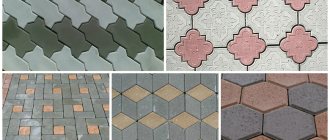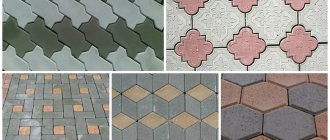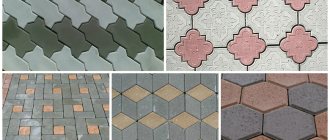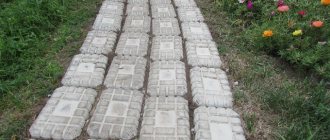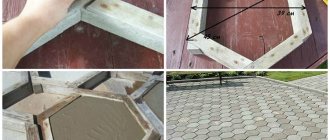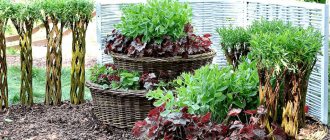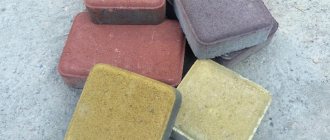Do-it-yourself tile flower beds allow you to effectively decorate your garden plot. This building material is easy to use and does not cause any particular difficulties during processing. The use of tiles makes the flower garden easy to care for and aesthetically attractive. There are many options for use; with its help you can create a flower bed of any shape and size. Here it is important to stock up on a sufficient amount of consumables, decide on the configuration, and follow a clear algorithm of actions.
Advantages and disadvantages
A flowerbed made of tiles in a country house has gained its popularity thanks to the following positive characteristics:
- consumables are freely available (there are a lot of leftovers after repair work);
- variety of color solutions;
- resists negative environmental factors well;
- does not fade/destroy when exposed to ultraviolet rays;
- tolerates negative temperatures;
- does not emit harmful substances;
- does not cause difficulties during installation work;
- easy to use;
- easy to clean from dirt.
A do-it-yourself tile flowerbed fits perfectly into any landscape design.
Among the disadvantages of tiles in the design of flowerbeds it is worth noting:
- the formation of ice on its surface in winter;
- with poor-quality installation, weeds sprout;
- absorbs moisture (paving slabs).
Paving pattern
The choice of an interesting and suitable pattern for laying paving slabs may depend on a number of important factors that can greatly influence the choice of materials, their quantity and the additional work required:
- features of the terrain on which the work will be performed;
- the shape and size of the path or area being developed;
- architectural features of the buildings that are located around;
- the final purpose of the future site.
Properly laid out high quality material can last up to fifty years. Therefore, you should choose a drawing very carefully and carefully. Mostly for private houses, rectangular tiles are chosen, which are considered classic.
Patterns are created by alternating colors or sizes of tiles used. Working with figured tiles is much more difficult, but it allows you to get a very interesting result.
Which tile is suitable for a flower bed
You can make a beautiful flowerbed in your garden using tiles or paving slabs. Glossy ceramics are good to use as a facing material. You can create any patterns from its fragments; the mosaic design will look impressive.
Ceramic tiles can be used in any format as decor for a flower garden; they are good for laying out patterns
Curly elements of paving slabs are good for making fences for flower beds in the garden. Their use will be especially original if the territory of the personal plot is made of a similar material.
Which pattern should I choose?
This question is probably faced by all owners who decide to decorate the road with an interesting pattern. Any paving is painstaking work, even if you work according to a diagram or lay out a simple pattern.
It’s important to decide right away, because you definitely don’t want to lay the tiles again.
It is worth choosing a paving scheme based on factors such as:
- landscape;
- site architecture;
- place of installation;
- dimensions and configuration of the site.
- Usually, based on all these factors, not only the pattern is chosen, but also the thickness of the tiles. The paved road will remain with you for a long time, because the average service life is 40-50 years. A paved road with a creative tile pattern will not only create a pleasant impression, but will also “model” the space around it, visually expanding or narrowing it.
- If you plan to beautifully decorate the space under or around any building, it is best to lay paving stones in a circle. This way the building itself will be in the center, and it will be much more convenient to approach it. It would be logical to make a parking space or next to a playground in a retro style using thick bricks. This will not only look beautiful, but will also make cleaning the area easier.
For a path between trees or in a garden, the classic method is more suitable.
Decorating flower beds with your own hands with tiles
Anyone can make a fence for a flower bed from paving slabs or ceramic. The main thing is to have a creative approach and decide on the arrangement option.
Tools
To create a flower bed from tiles with your own hands, you need to prepare the following consumables and tools:
- shovel;
- building level;
- roulette;
- grinder with a disc for cutting tiles;
- welding machine;
- putty knife;
- hammer;
- Master OK;
- container for mixing the working solution;
- saw;
- drill;
- manual rammer;
- sand;
- Portland cement.
Preparation
To effectively fence a flowerbed with perennial plants with your own hands, you need to carry out a number of preparatory measures:
- Mark the boundaries of the flower garden.
- Dig a trench 15-20 cm deep.
- Install the formwork using lumber and plywood sheets, providing spacers on the outside and pegs on the inside. The height of the structure must correspond to the height of the future fence.
How to do
The algorithm for carrying out work on arranging a flowerbed with your own hands involves performing the following actions:
- Prepare a working solution from sand (4 parts), cement (1 part). Its consistency should be creamy.
- Place crushed stone at the bottom of the trench, layer thickness 10-15 cm. After this, pour sand in an even layer, approximately 5-10 cm.
- Fill the sand-cement mortar. When finished, level the surface. Allow time for the concrete mass to dry completely, 48 hours.
- Prepare small fragments of ceramic tiles.
- Lay the mosaic on the diluted tile adhesive using characteristic vibrating movements, performing twisting. Such manipulations are necessary to eliminate the air gap under each fragment of ceramic tile. This simple technique will allow the facing material to come into good contact with the base. There is no need to rush here; it is important to lay out the tiles carefully, maintaining a certain concept.
- Perform troweling work in 2 stages. The first time the manipulation is performed using a liquid working solution prepared as for a concrete fence. Primary grouting is necessary to fill all existing seams. After this, the seams need to be treated with decorative grout of a suitable color pigmentation.
Styling tips
When purchasing material, you must remember that there will be a certain amount of tile waste in the form of trimming elements. At the same time, you cannot purchase tiles strictly for a certain quantity for a designated area; there must be a small supply.
This is due to the fact that during transportation or working with the material, defects may form.
In addition, if there is not enough material, you will need to buy more, and the next batch may already have a different shade, which will immediately catch your eye against the general background. It is also not recommended to purchase very bright tiles, since a large amount of pigment leads to a decrease in the strength of the material.
- You can carefully split the tiles only if they have been previously trimmed using a grinder.
- You can completely saw the required element, but this takes more time and materials.
- If the work is carried out to create a platform for parking a car, then a reinforced concrete base is required. The tile itself can have different thicknesses - from 4 to 10 cm.
- For pedestrian paths, a material 4 cm thick is used; if there is constant movement along the alley on bicycles, then the thickness of the tiles should be at least 6 cm.
- For the movement and parking of passenger cars, it is necessary to use tiles with a thickness of at least 8 cm, and for the movement of trucks - at least 10 cm.
How to make it yourself
Depending on the manufacturing method and the chosen building material, a flower bed for growing annual and perennial crops is made in compliance with a clear sequence of actions.
From paving slabs
You can make a stationary version of a flower bed in the garden with your own hands by analogy with laying paths using the dry method. The step-by-step manufacturing process is as follows:
- Dig a 10 cm deep ditch around the perimeter of the future flower bed. Its width will depend on the thickness of the building material used.
- Place geotextiles on the bottom and a layer of sand on top. After this, everything needs to be leveled and compacted well. The thickness of the layer will depend on the volume of paving slabs that are planned for arranging the flower garden. In addition, the parameter will depend on how high the curb will be raised, or whether it will remain level with the lawn.
- When laying tiles, you need to carefully hammer each one into the sand using a mallet. All fencing elements must be at the same level.
Paving slabs are great for repeating and emphasizing the color and texture of garden paths and fences. Thanks to this method of use, it is possible to effectively get rid of remnants of paving materials.
Advice! The most optimal and original option for fencing flower beds when mowing the lawn is a border made of paving slabs laid flush with the surface of the green carpet.
Bathroom tile flower bed border
To create a border for a flower bed from tiles with your own hands, you need to decide on the size of the flower bed, prepare a sufficient amount of facing material and make a concrete base. Step-by-step instructions for making a flower bed from tiles:
- Mark the area for the flower bed.
- Dig a trench 15-20 cm deep, the width will depend on the intended design and personal preferences.
- Install formwork from boards and spacers with pegs.
- Place crushed stone at the bottom, a layer of 10 cm, and sand - 5 cm. Prepare a sand-cement mortar.
- Pour the structure to the desired height and allow the concrete mass to dry completely. This will require at least 48 hours. Work on pouring cement mortar should not be carried out in wet weather.
- Using tile adhesive, diluted according to the manufacturer's instructions, begin tiling work - laying tiles for the bathroom; such a border for a flower bed can be made in a monochromatic style, or have a contrasting, creative solution.
From broken tiles
Before using broken ceramic tiles for decoration, you need to make a sketch. Using colored pencils on a sheet of paper, draw a plan for the placement of tile fragments and think over a pattern. Step-by-step process of arranging a tile border for a flower bed with photo:
- Having decided on the boundaries of the flower bed, dig a ditch 15-20 cm deep.
- Make formwork from available materials. Lumber, sheets of slate and plywood are suitable for these purposes. To strengthen the frame, wooden pegs are installed inside, and spacers are installed on the outside.
- Make a border from cement-sand mortar with the addition of small crushed stone. Upon completion of work, level the surface of the fence using a trowel.
- Lay a mosaic of broken tiles according to a pre-designed pattern.
Production methods
The main elements from which paving slabs are made are sand and cement. The following can also be added to the solution:
- granite chips;
- marble chips;
- pigment.
The quality and technical characteristics of the material depend not so much on the composition and proportions of its components, but on the production technology.
Vibration pressing
The mold for making tiles is located on a vibrating bed. Due to vibrations, the dry mixture in the mold is compacted. To speed up the process and improve quality, force is applied to the mass. This is done using a vibrating punch until the required density is achieved. After the process is completed, the punch and mold are removed, and the finished product remains on the bed. The products obtained in this way are of high quality and have a service life of about 25 years.
Hyperpressing
This method is used for accelerated production. With this manufacturing method, the vibration process is replaced by a high-pressure pressing process. The resulting mixture is homogeneous. This production method is considered one of the most expensive, as it requires special high-quality equipment.
Vibrocasting
The cheapest way to make paving. Forms are placed on a vibrating table into which the liquid solution is poured. A vibrating tabletop is needed in order to partially separate the solution into fractions. Cement laitance forms on the surface, after which the workpieces are removed from the table, covered with a special film and placed in a separate room to dry. Drying lasts about a day, but for the material to acquire the required level of strength, it must lie in the warehouse for about a month. Look at examples of photos of paving slabs in the yard.
Flowerbed care
To create a bright accent in the garden, it is important not only to know and be able to properly decorate a flowerbed with tiles, but also how to properly care for it. In order for the flower garden to delight others throughout the season and not lose its high decorative characteristics, you must adhere to the following recommendations for caring for it:
- Carry out regular and timely irrigation activities. Plants must be selected with the same requirements for growing conditions, soil moisture and nutrition.
- After irrigation, loosen the soil to avoid the formation of a dry crust on the surface. Otherwise, the roots of ornamental crops will experience oxygen starvation, begin to get sick, wither, and shed flowers and leaves.
- Remove weeds. If there are weeds, the crops will not have enough nutrients or moisture. It is convenient to do this together with loosening the soil.
- If necessary, prune plants that have already bloomed. To prevent faded buds from spoiling the appearance of the flowerbed, they also need to be removed.
- Apply fertilizer compounds. With insufficient nutrition, both annual and perennial plants will have reduced immunity. They will not be able to fully resist pathogens. To feed flowering specimens, it is good to use mineral compositions twice a month, with an interval of 15 days.
- Plantings should not be allowed to become dense. In such conditions, where there is a lack of light and heat, the plants begin to stretch out greatly and weakly form buds. In addition, decorative crops planted very densely are more quickly attacked by harmful insects and pathogenic microorganisms.
- Given the rapid growth rate of the root system of many plants used for flower beds, it is recommended to update them every 3-4 years. In autumn or spring, those specimens that have grown greatly need to be dug up and their roots divided into sections. After this, they are assigned to a permanent place in the tile flower garden. The main thing here is to know when it is better to carry out these manipulations so as not to harm the plants. For example, the optimal time for dividing irises is June-end of summer.
Only an integrated approach, compliance with all the rules of agricultural technology, allows you to maintain the presentable appearance of a flower garden equipped with tiles for a long time. For beginning gardeners, you can first create a medium-sized flower bed, only a couple of meters in diameter, or make several miniature ones.
Advice! To make a round flowerbed made by yourself look more advantageous, its central part should be slightly raised.
Other layout options
There are many other ways to lay paving slabs. For example, artistic. It requires considerable skill and fairly developed skills in working with tiles. Laying tiles in this way is possible if the scheme is carefully developed and there is an experienced person nearby.
- The artistic layout does not have a single style and, as a rule, the drawing depends only on your imagination. It can be a geometric abstract composition, mosaic, ornament, radial or square layout, a combination of them, or even some kind of optical illusion. If you are not confident in your abilities, it is better to contact landscape designers.
Another type of layout is “random” or “chaotic” - a universal solution if you have different types of tiles on hand. This scheme is perfect for decorating a local area or garden paths. You can lay out the bricks however you want, in any order. Chaos is the basis of this method. After completing the work, you can be sure that your site is unique.
By the way, landscape designers are very fond of this method: they combine different colors and shapes and create incredible compositions from paving stones.
Photos of flowerbeds made of tiles in garden design
In the photo you can see examples of successfully completed flower beds.
On a personal plot, it is easier to care for several small flower beds than one large one. Before you start decorating a flower bed with broken tiles, for ease of execution, you should first make a sketch on paper, and only then work on it. Ceramic tiles for a bath can be used to arrange a flower garden using a pre-prepared frame made of metal profiles. The more diverse the mosaic is, the more profitable the flower garden at the dacha looks. When designing a flower bed from tiles, it is important to think about both the design of the structure and the plants that will be planted on it.
We organize the markings
To avoid chipping and cutting the tiles to the required size, it is recommended to adjust the area prepared for paving to the shape of the tiles. This will help strengthen the stability of the laid path.
It is very important to leave space for mounting the curb, since without it it is difficult to achieve the integrity and security of the path.
Pegs, cord and tape measure are used to calculate the required distance. A not particularly deep ditch is dug along the area of the future path. Inspect the prepared route before laying the tiles; if you like everything, then you can move on to other stages.
